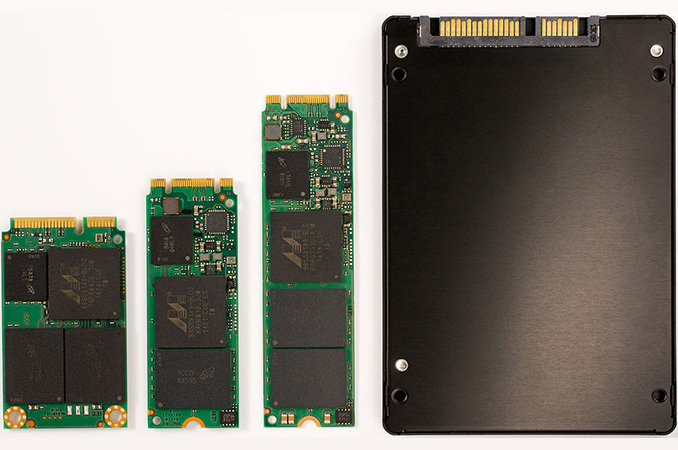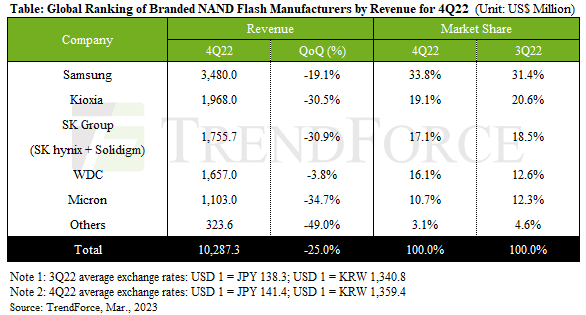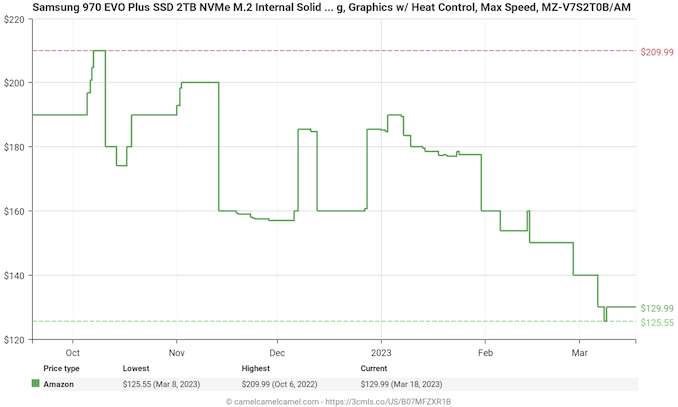NAND Flash Prices Have Dropped Rapidly In Recent Quarters - And So Have SSD Prices
by Anton Shilov on March 20, 2023 9:00 AM EST
Softened demand for PCs and smartphones coupled with NAND memory bits oversupply has sent prices of 3D NAND memory into a dive in recent quarters. In Q4, global NAND flash revenue dropped staggering 45% year-over-year and 25% quarter-over quarter, according to recent data by TrendForce. And while that dive appears to be leveling off some – TrendForces' analysts forecast that NAND prices declined more modestly in Q1 – it's still bringing NAND to its lowest per-bit costs ever. All of which has meant that SSD prices for end users have been taking a much-welcomed dive, as the core costs of building SSDs continue to decline.
NAND memory manufacturers earned $10.287 billion in Q4 2022, down 25% sequentially and 45% year-over-year. Average selling price (ASP) of NAND memory decreased by 22.8% sequentially as makers of flash tried to dispose of memory devices they had produced. Meanwhile, PC, smartphone, and server vendors were hesitant to purchase more 3D NAND than absolutely necessary, as they were unsure about future demand and feared overstocking.
Samsung Remains on Top of NAND Market
Samsung retained its top spot with $3.48 billion in NAND sales (down 19.1% QoQ and 43% YoY) and a 33.8% market share. Despite declining ASP, Samsung has managed to increase its total bit shipments by leveraging its cost advantage and focusing on high-capacity products. Furthermore, the company has not announced any plans to reduce its 3D NAND bit output so far, unlike all of its industry peers, including South Korea-based SK Group.
Kioxia earned $1.968 billion on 3D NAND (down 30.5% QoQ and 44.5% YoY) and commanded 19.1% of the market. Kioxia sells both raw NAND memory as well as datacenter SSDs, so soft demand from PC and smartphone customers and as well as inventory adjustments by server makers spiraled the company's revenue.
NAND sales of SK Group (which owns SK Hynix and controls Solidigm) reached $1.7557 billion in Q4 (down 30.9% QoQ and 51.4% YoY) and the company was the third largest supplier of flash memory with a 17.1% share. TrendForce says that while SK Group's NAND earnings declined, the company increased its flash memory bit shipments by 6.7% QoQ as shipments of 3D NAND for consumer electronics as well as sales of enterprise SSDs increased.
Western Digital, which controlled 16.1% of NAND sales in the fourth quarter, sold $1.657 billion worth of NAND memory, a slight 3.8% drop sequentially and a 46.8% lower than in the same quarter a year ago. But those slight drops of revenue were a result of a massive 20% increase in bit shipments, something that clearly had an effect of the company's ASP in Q4.
Micron's sales of NAND flash totaled $1.103 billion in Q4 2022 (down 34.7% QoQ and 41.3% YoY) and controlled 10.7% of the market. Micron was the first company to announce plans to cut its 3D NAND bits output late last year. Nonetheless, Micron initiated shipments of its client SSDs based on 232-layer 3D NAND in Q4 2022, according to TrendForce. Furthermore, as Micron ramps up production of enterprise-grade drives featuring 176-layer 3D QLC NAND, TrendForce projects that Micron's bit shipments will gradually improve in 2023, resulting in a steady increase in revenue quarter by quarter.
SSD Prices Reach New Lows
Samsung not only controls a third of NAND flash memory market, but it also sells some of the industry's most popular SSDs. Seven out of 10 bestselling SSDs at Amazon carry Samsung's badge. Meanwhile retail prices of popular SSDs from of all vendors typically followed trends set by prices of 3D NAND flash. To get a better look at the change in SSD prices over the last few months, we pulled some data from Amazon tracker CamelCamelCamel to see where prices stand since the start of Q4'22:
- Price of Samsung's mainstream 970 Evo Plus SSD 2 TB fell from $210 in October to $160 in December, 2022. The product can be purchased for $130 today, for a 38% drop.
- Samsung's 870 Evo 1TB drive used to cost $105 in October and dropped to $90 in December. Its price collapsed considerably more drastically in Q1 and it is sold for $65 today, for a 28% drop.
- Interestingly, pricing of Micron's Crucial MX500 1TB SSD behaved slightly differently in Q4: the drive used to cost $85 in September, then temporarily dropped to $75 in October, returned to $85 in November only to collapse to around $75 in December. At press time the product cost $60, for a 29% drop.
- Western Digital's higher-end WD_Black SN770 1 TB SSD was less prone to price decline in Q4: it was sold for $100 throughout the whole quarter dropping to $80 for a few days. Yet, right now this drive is available for $60, a 40% drop.
- Pricing of another popular high-end PCIe Gen4 x4 SSD — the Samsung 980 Pro 2TB — was quite unstable in Q4 varying from $240 in September to $180 in December. Today, this drive can be acquired for $160, which is an increase from $160 earlier this month, and a 33% drop overall.
- Meanwhile SK hynix's P31 2TB, a PCIe Gen3 SSD popular with laptop users, has bobbled up and down, owing to SK hynix's tendency to put the drive on sale for short periods of time. It started at $160 in late September, rising as high as $208, before finally coming down to $120 in recent weeks, a 25% price drop.
- And SK hynix's P41 2TB, their more recent PCIe Gen4 SSD, has been even more stable in price. The previously $260 drive is currently selling for $245, a drop of all of 6%. It has sold for far less — $170 — when it is on sale.
NAND Prices to Drop Further
TrendForce believes that NAND flash revenue and ASP decreased further in Q1 2022 due to traditionally low demand during this period. As announced, Kioxia, Micron, Western Digital, and SK Hynix are expected to continue reducing their production in the first quarter to address their overstock situation, though it is unclear how this will affect their bit shipments, as the companies tend to produce memory using their latest production nodes. Yet, lower output will likely reduce ASPs by 10% - 15% QoQ in the first quarter, according to TrendForce.
As a result, TrendForce forecasts an 8.1% decline in NAND flash revenue in Q1 2023. Meanwhile, a quick check of retail SSD prices at Amazon demonstrate that they are getting cheaper, making the current NAND price bust a win for PC parts buyers.
Sources: TrendForce, Amazon, CamelCamelCamel


















19 Comments
View All Comments
deporter - Monday, March 20, 2023 - link
I just wish high capacity (4TB+) SSDs were cheaper. No need to be very fast, just cheaper. Having to use HDDs for storage sucks.Threska - Monday, March 20, 2023 - link
Define cheaper. Crucial 4TB SSD is roughly $268 which isn't bad for that size.dwillmore - Monday, March 20, 2023 - link
Price parity with smaller drives, I would assume. So, $180/$190 for lower performance 4T drives.Golgatha777 - Monday, March 20, 2023 - link
I recently purchased 2x2TB WD SN850X drives for $160 each. Would have gladly paid $320 for a 4TB one, but they're still sitting at $400 each.meacupla - Monday, March 20, 2023 - link
Locally, I can buy a Lexar NM610 1TB for approximately $37USD. Unfortunately, the 2TB model is $92.iwod - Tuesday, March 21, 2023 - link
Where is that? $37 for 1TB is just amazing. Even 2TB is not bad considering most are still above $100.meacupla - Tuesday, March 21, 2023 - link
It's a canadian computer store.meacupla - Monday, March 20, 2023 - link
The 1TB NVMe models are really cheap right now, with 2TB SATA SSDs being even better with gb/price.And you're telling me this is going to drop even further? damn
I also noticed DDR4 prices plummeting. If anyone still needs some.
Threska - Monday, March 20, 2023 - link
Good reason to max out one's board. Maybe even throw in some ECC.nandnandnand - Monday, March 20, 2023 - link
https://www.digitimes.com/news/a20230301PD220/memo...I think DDR4 could be plateauing soon before rising again. I'm trying to lock in a DDR4 SO-DIMM purchase but I haven't seen the right deal in the last couple of weeks.